This article is more than 1 year old
EMC intros the mini VMAX
For those who don't want their back-ends compromised
EMC has formally launched its down-sized VMAX, the VMAXe.
The system is physically smaller in size than VMAX, coming in a 19-inch rack and only needing single-phase power. It uses the VMAX architecture and software (Enginuity 5875+) and is a pre-configured hardware and software offering with optional fully-automated storage tiering (FAST VP), thin provisioning – which EMC calls Virtual Provisioning – PowerPath SE automated path failover software, and RecoverPoint replication.

EMC's VMAX and VNX product range positioning
There can be up to four processing engines, compared to VMAX's eight, each with 96GB of cache, and up to 960 FC and SATA hard disk and solid state drives, providing 1.3PB of capacity. We understand supported drive types include 450GB 15k FC, 600GB 10K FC, 2TB 7.2k SATA, and 200GB SSD.
Each engine supports from 24 to 240 drives. Apparently some international configurations can have more than 1,000 drives. VMAXe cannot be upgraded to a full VMAX.
EMC stays it takes four hours to install and can then process its first I/O, having had 1TB of storage provisioned, in just four minutes.
It positions VMAXe for departmental or development use cases where a full VMAX is not appropriate, but where VMAX features and/or compatibility is required instead of top-end, dual-controller VNX storage features.
VMAXe processors
The processor arrangement is different from the standard VMAX, which uses two quad-core Intel Harperton processors per VMAX engine, providing 16 cores per engine and 8 cores per VMAX director.

VMAXe uses Westmere CPUs with 8 hyper-threaded cores per engine and 4 cores per director, apparently half the core count of VMAX directors. EMC's Barry Burke, a chief strategy officer in EMC's Information Infrastructure Group, says the hyper-threading means that VMAXe has 8 "virtual cores" and can thus support "the same number of open systems front-end connections and the same number of back-end (redundant) drive channels" as standard VMAX can.
The competitive product environment includes HP's 3PAR offering, IBM's XIV and DS87000, HDS VSP arrays and the HP Hitachi-sourced P9000.
EMC hopes its channel will take to the VMAXe and Burke says its "pricing, packaging and delivery has been developed to be very channel-friendly."
Pricing has not been revealed, but there will be a flat fee per terabyte capacity, and VMAXe in general should be 15 to 20 per cent less than VMAX. A fully configured VMAXe might cost more than a minimally configured VMAX, and a minimally configured VMAXe might be less than a top-end VNX. ®
